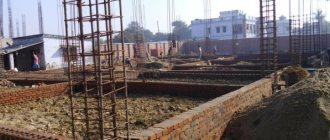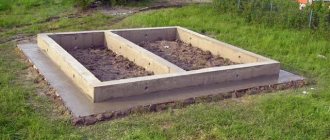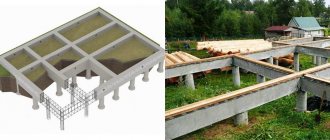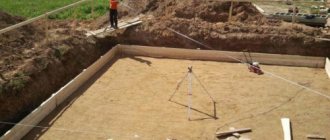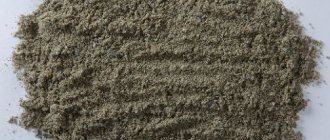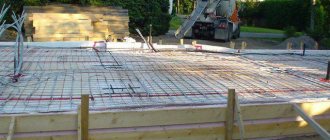PGS under the foundation, or sand-gravel mixture, is widely used when equipping foundations under foundations. You need to choose a material that meets a number of requirements. We will talk about them in this article.
From the Soil Trucks company you can buy ASG for foundation cushions with delivery to your site at the lowest price.
The price for PGS for the foundation is from 600 rubles. for 1m3 Order
But first, a few words about why an additional layer is made under the foundation of the house.
The pillow under the foundation performs several functions:
- Levels the surface
- Evenly distributes the load of the foundation and the building itself onto the ground
- Reduces building shrinkage
- Stabilizes the base
- Partially replaces weak soil
It is important to note that the pillow does not provide drainage. It can only partially reduce the capillary penetration of moisture under the base. If the aquifer is located high, deep drainage must be installed. To protect the foundation from heavy rainfall and melted snow, waterproofing, blind areas, and, after construction are completed, storm drains are made.
Why do you need a pillow under the foundation?
Many people know that a foundation built with violations creates impossible living conditions. The walls begin to become covered with cracks, blocks of windows and doors become warped, and drafts appear in the rooms.
Therefore, the rules of the device must be followed, and one of them is a pillow under the foundation. This load-bearing structure promotes optimal redistribution of load effects from the object and eliminates the phenomenon of subsidence. In addition, the foundation cushion makes it possible to raise the bottom of the supporting structure in relation to the groundwater level.
Most often, the artificial foundation is made of sand. Do not confuse the pillow with ordinary sand preparation, the layer of which is much thinner. The installation of a cushion under the foundation is carried out in order to improve weak or subsiding soil in order to replace the heaving soil composition with a non-heaving one directly under the foundation structure. The dimensional parameters and shapes of the pillow are determined taking into account the existing features.
Let's consider the need for arranging a pillow using the example of a layer formed from sand. It performs the following functions:
- alignment. This is the main purpose of a proper foundation cushion, since it helps level the bottom of a foundation trench or pit. The cushion must be poured under a slab foundation or under a FBS base, that is, under all prefabricated structures. Quite often, the bottom of the pit after construction equipment has unevenness, which, in order to save money, is leveled with sand;
- redistribution of load effects. Many experts claim that the pillow is able to distribute the load. But where? The fact is that the load forces are distributed evenly in any case - with or without a pillow. It is believed that the sandy base reduces the pressure on the soil composition and protects against possible soil movements, compensating for them;
- drainage functions. If you pour a sand cushion thirty centimeters thick under the foundation slabs, the capillary connections in the soil will be destroyed, and water will not flow into the foundation;
- protection against winter heaving. Sand drains water well, and it is best to replace heaving soils in order to give stable stability to the foundation structure. Just remember that the technology provides for drainage so that water accumulating in the sand does not aggravate the situation.
Now you know why you need a pillow under the foundation.
Types of pillows for the foundation
Let's look at the main types of foundation pillows.
sand cushion
A sand cushion is a very common type of base for tape, especially for one-story buildings due to the availability and low cost of the building material. For its construction, coarse-grained river or quarry sand is taken. When calculating the volume of building material, you need to add approximately 15% for compaction. Sand has its advantages:
- drains rain well;
- absorbs groundwater;
- acts as a shock absorber during heaving;
- increases the thermal insulation properties of the structure;
- compacts well.

Sand base is most often chosen in the following cases:
- for light and one-story buildings: houses, garages, outbuildings;
- when it is necessary to replace loose soil under the foundation with more compacted one;
- under shallow foundations to cut off capillary suction.
The dimensions and thickness of the sand base are selected based on the type of soil, number of floors and building material, and soil characteristics. The thickness of the sand base under the tape depends on its width. 15 cm thick is poured under the slab 30 cm thick under piles and pillars , in addition it should be wider than the size of the pillars by 15-20 cm in circumference. On clay soils, the thickness of the cushion can reach half a meter . In this case, sand is poured in layers of 15-20 cm and each layer is spilled and compacted.
Advice! Experts do not recommend making a very thick base, since it is difficult to predict how it will behave in extreme conditions.
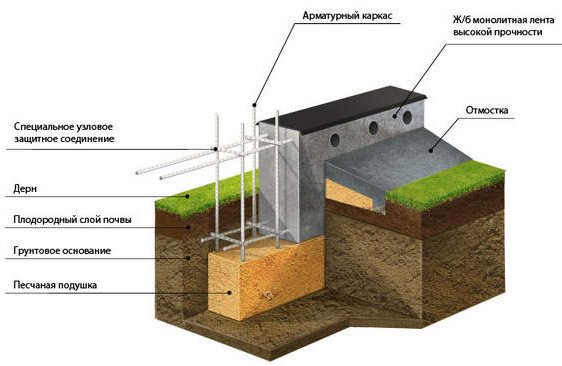
sand cushion
In addition, to install a high-quality sub-base in a place with high groundwater level, you will need waterproofing material , for example, geotextiles or roofing felt. The fact is that sand absorbs water very well, which, without waterproofing, will rise through the pores of the foundation concrete up into the walls. Geotextiles are laid both under the sand layer and on top. The layers laid on it are pre-compacted with a tamper. For better compaction, it is better to water the sand.
Gravel bed
The crushed stone cushion is also very popular due to its simple backfill technology and greater strength than sand. Crushed stone for these purposes can be taken of two types: gravel and granite. Limestone is not suitable for such tasks due to its low quality .
Gravel is a type of crushed stone obtained by sifting quarry or river sand. Crushed gravel is used in 90% of cases for backfilling the foundation. It has a more affordable price compared to granite. Crushed gravel has a rounded grain shape.
Gravel absorbs less water than sand and can withstand greater loads . Thanks to this feature, the crushed stone cushion can serve as a base for the foundation of two- and even three-story buildings. In terms of cost, this option will be more expensive than sand backfill.
Concrete pad for foundation
Concrete base is rarely used in private housing construction due to its high cost and labor-intensive pouring. However, it is she who has the greatest strength among all those presented. The concrete base is made in the same way as the foundation design, only thinner. In general, filling can be divided into the following stages:
- excavation;
- installation of sand bedding, its compaction;
- waterproofing device;
- pouring a thin layer of concrete;
- erection of formwork;
- installation of a horizontal reinforcing layer;
- pouring concrete;
- bayonet;
- drying period.

Concrete pad
This way you get the strongest pillows for the foundation.
Reinforced concrete pad for the foundation
A support option for prefabricated foundations is special ready-made trapezoidal products. Inside them there is a steel reinforcement frame. It is the foundation pads that are used for the construction of large buildings.
They are designed as a support for ready-made foundation blocks. On the top of the product there are eye loops designed for easy gripping by a crane. Additional products are produced for the main blocks . Advantages of reinforced concrete pads: versatility , durability and quick installation . The disadvantages include the need to use special equipment to work with them.
In private housing construction, blocks are used for the construction of manor-type houses, as well as for the construction of luxury houses. Before starting work on their installation, the bottom of the pit or trench is leveled or compacted. On unstable soils, a sand base can be used for leveling purposes.
On the leveled and compacted bottom, blocks are placed end to end so that a line is formed. The resulting sinuses are sealed with cement-sand mortar. Concrete foundation blocks with bandaging are installed on the upper plane.

Blocks for the foundation
Combined use
When choosing a material, the question may arise: what is better to use for a foundation cushion: cheap sand or durable crushed stone? Both types are most often used. As already mentioned, the bottom layer of the crushed stone base is sand.
Also, in sand analogues, crushed stone is used for reinforcement (for example, in the construction of columnar foundations).
Device depending on the foundation
All builders know why a sand cushion under the foundation is needed. But not every specialist is convinced of its effectiveness. There is an opinion that it is not suitable for certain options.
Tape
Strip foundations are used with a thin sand cushion only for small buildings.
The calculation of the sand cushion must be carried out so that its width is several tens of centimeters greater than the width of the tape.
To level the ground and avoid liquid penetration into the foundation, as well as for other purposes, all actions must be performed in the correct sequence:
- Place a layer of sand that is necessary for a given type of soil and distribute it evenly over the area.
- Moderately moisten the sand with water so that it settles more tightly and is easier to compact.
- In order to get a dense pillow without voids, and the house does not sag, they resort to special construction equipment for compaction.
- Any unevenness on the cushion is eliminated so that this does not have to be done later during the construction of the foundation.
- Treat the working surface with a waterproofing layer.
It is important to check the thoroughness of compaction. If there are no marks on it, then the work was done correctly.
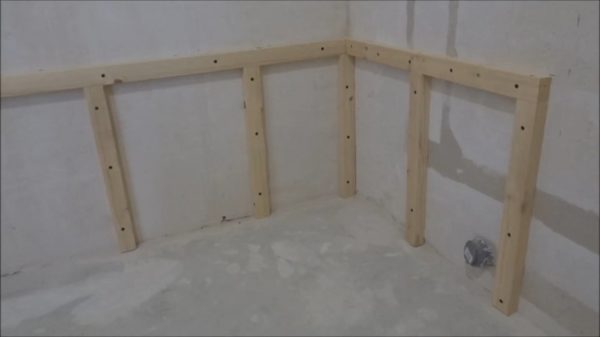
A sand cushion under the foundation is not needed if a monolithic base is used. This is possible provided the soil is not heaving. Also, a foundation cushion without sand is allowed if you plan to build a house on sandy soil.
It is impossible to create a base from FBS without a sand cushion. Such a foundation on a sand cushion without deepening requires preliminary leveling of unevenness formed after removing the loosened layer of soil.
If you place a foundation made of blocks directly on the ground, then voids will form under it and the house will gradually sag unevenly.
Columnar
A column foundation is a solid foundation, but it must be supported with sand and gravel. What sand or crushed stone should be found out first to avoid serious mistakes. First, medium-sized solid fractions of gravel are placed under the pile foundation and all this is diluted with sand. To ensure that the components fit together more tightly, they are filled with a small amount of water and tamped down.
The height of the sand cushion is allowed up to 30 cm.
Finally, polyethylene is placed on the surface to prevent water from being absorbed into the pillow.
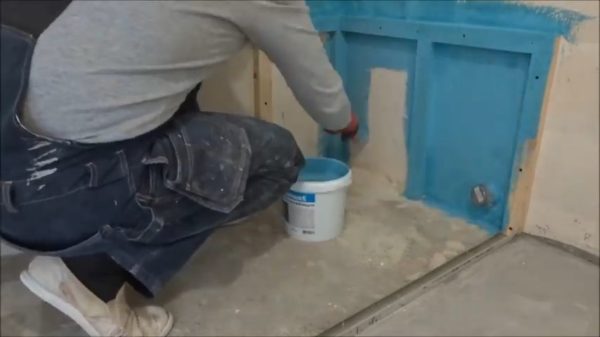
Slab
A slab foundation on a sand cushion has the same structure as a strip foundation, but is carried out over the entire area of the pit. To create the correct layer, you need to find out how to do it and whether it is needed for this type of base. The procedure is carried out as follows:
- Dig a hole in the ground under the foundation and carefully level its bottom.
- A certain amount of gravel or crushed stone is placed there. How many centimeters to pour is determined by the density of the soil. If it is small, then fifteen centimeters is enough.
- Sand is poured onto the crushed stone. Which is better, river or quarry, is chosen at your own discretion. If you are planning a small cottage, then 10 cm will be enough. This will distribute the load equally over the entire base area.
- Compact using a vibrating plate.
Whether a layer is needed or not, many builders argue. But the majority agrees that it is impossible to do without it.
Before installing the foundation, cover the sand with waterproofing.
Pile foundation
The ideal option for complex geology and terrain of the site is the construction of a pile-grillage foundation. Regardless of the composition of the soil, the piles penetrate through heaving, unstable horizons and rest on a layer with a high bearing capacity.
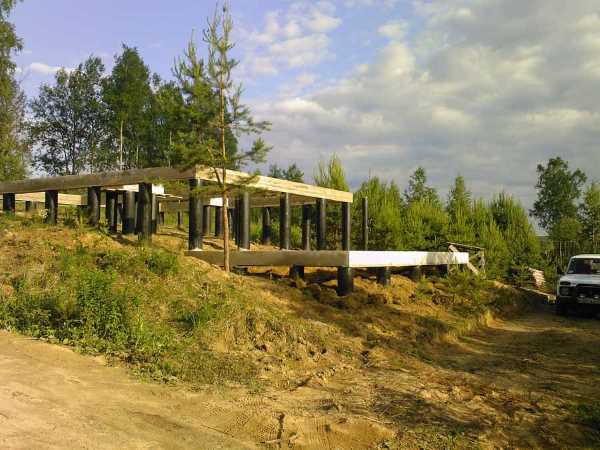
With a hanging grillage, heating the soil under the building is impossible, and there is no need to retain geothermal heat. Due to the small diameter of screw piles, pull-out forces are usually not taken into account. Bored structures are much thicker, but for concreting you can use a perfectly smooth polyethylene pipe as formwork. When the soil swells, it will slide over its surface without causing damage to the foundation structures.

Construction stages
Preparation of the foundation of the building is carried out in several stages.
Marking the area for the foundation
The area is marked according to the house plan. All waste, plants, uprooted bushes and trees were removed. It is advisable to remove about 10 cm of the top layer of soil.
Pegs and tensioned ropes are used to mark the boundaries of the house and all load-bearing internal walls. You should check whether the angle between the walls is strictly 90º, unless the design involves complex wall configurations.
Trench
In this case, the trench is used for convenient formation of piles. It is dug to a depth of no more than 40 cm and width, which allows you to easily install wooden formwork and dig pile holes.
Once construction is complete, the trench can be buried as the concrete belt acting as a grinder should not be on the ground. Sand can be poured under the tape to the desired height.
Where to dig the pillars?
The number, diameter and depth of piles must be determined at the calculation stage. Supports are installed in the corners of the building, under load-bearing walls, in the corners where these walls are connected and where heavy equipment must be installed.
If, for example, it is necessary to install a stove, chimney, etc., then in this case it may be necessary to strengthen the foundation. In this case, it makes sense to install the piles at the corners of the reinforced pile.
Holes for the piles are drilled and selected in accordance with the calculated diameter of the piles. The diameter must be slightly larger to allow for the installation of formwork and compaction.
To save concrete, you can increase the area of the pile pillar on the ground due to its wider base. This means that the diameter and weight of the pile do not increase, and the load on the ground is reduced due to the wider supporting surface. This can be done using a special drill. TISE.
Watch out guys! For the record, drill. TISE Differs from the usual presence of a mounted plow, which allows the creation of a larger diameter cavity in the desired part of the excavation under the stand. The bottom of the plow is covered with sand, possibly gravel, in a layer of about 10 cm.
Formwork
Before concreting, the formwork must be made and the hole for the pile must be reinforced. The formwork can be used as formwork for slabs, plywood, metal, special slabs, workshop panels, etc. The formwork can also be used as a formwork for piles. The holes are sealed with 2 layers of foam roll material.
The formwork for the pile can be an asbestos-cement pipe, which then remains in the ground. Rubber and pipes are inserted into the pile hole to the end. Inside, the reinforcement forms a reinforcement cage with a diameter of 12-16 mm.
Depending on the diameter of the pile, the reinforcement can be installed in the form of a rectangle or triangle with a central rod in cross section. The vertical segments are connected by horizontal rods and wires at approx. 30 cm. The reinforcing steel should be located in the middle of the pipe, without touching the walls.
The ends of the reinforcement should protrude 15-25 cm beyond the ends of the pipe, since they are connected to the reinforcement base of the foundation strip.
What requirements must the foundation cushion meet?
The following requirements apply to a pillow under any foundation:
- the material used must not contain impurities of plant origin. Sand and gravel must be clean, free of foreign particles;
- the material should not have heaving;
- the pillow should easily withstand freeze-thaw cycles without losing its properties;
- even under significant load, the material must allow water to pass freely and perform the function of drainage.
The sand and gravel pad under the foundation meets all these requirements. But here it is very important to choose the right source material. The sand is taken clean, without foreign impurities. The size of the fractions should be from 1 to 2.5 mm.
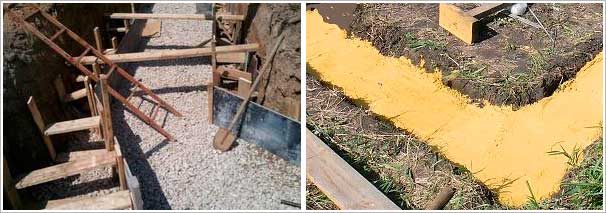
As for gravel, it is important to choose the right size and strength grade of the material. Suppliers can offer several types:
- crushed gravel - obtained by sifting rocks. This material is quite durable, and its cost is very affordable. This is the option that is used most often;
- granite is a more expensive, but also the most durable material; its minimum grade is M1200. It is produced by crushing granite blocks. Due to its high cost, it is not used as often as the first option;
- limestone is an inexpensive material with low strength. Can be used as bedding only in the construction of small houses with low mass.
There is an even cheaper option. After crushing concrete structures, crushed stone also remains. It can also be used to create a cushion for the foundation (of course, provided it is strong enough), although many experts do not recommend this.
In order for the backfill under the foundation to perform all its functions, it is necessary that the gravel used has the following two main parameters.
Firstly, the size of the fractions should lie in the range from 20 to 40 mm. Secondly, the strength grade of the material must be equal to or greater than M1200. In this case, the resulting pillow will cope with all the tasks assigned to it without any problems.
Dimensions: width, height, thickness
In order for the pillow to satisfy all the requirements, it is necessary to choose its dimensions correctly - width, length, thickness. They depend on the structure of the cushion itself, the load-bearing capacity and heaving of the soil, the type of foundation and the massiveness of the structure.
The width and length of the pillow is determined by the dimensions of the foundation . In the case of a strip foundation, backfilling is carried out along the entire length of the trench, and the width of the strip should exceed the thickness of the foundation strip by at least 7-10 cm on each side. The minimum permissible backfill width is 25 mm.
Features markings and sizes
Elements for the foundation differ in size and load-bearing capacity. Based on the second criterion, four groups are distinguished. Each group belongs to certain pillows, this is indicated in the labeling. The higher the marking number, the more loads the structure can withstand.
These elements are produced in different sizes, differing in length, width and height.
Each foundation pad has its own marking. What information is encoded in it can be found out using the example of the FL-10-24-3-N plate. The interpretation of foundation pillows with this designation will be as follows:
- FL – indicates the type of construction.
- Numbers 10.24 – description of dimensions. This indicator is measured in decimeters.
- Number 3 is the load-bearing capacity of the building element.
- H is a sign indicating how moisture penetrates into the concrete. In this case, N is normal.
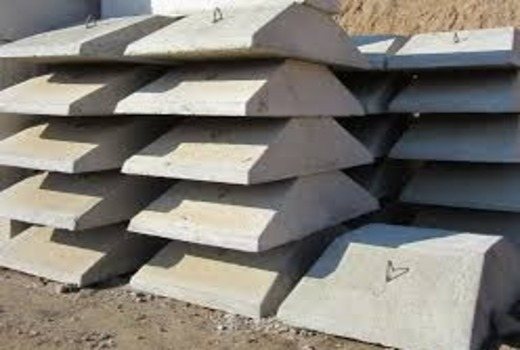
According to GOST, the manufacturer is obliged to leave a marking on the side of each element providing information about the building structure.
You can easily calculate the FL sizes for 400 blocks. If the height is 400 mm, then the width should be in the range of 600-1600 mm.
But it should be taken into account that the assortment of foundation pillows from different manufacturers differs in size and the cost is calculated individually for each element.
General rules for constructing a foundation cushion
We found out why this element is needed. Now let's look at the basic rules of construction, where to start in order to build a reliable foundation for a load-bearing structure.
The materials are laid in layers, with periodic compaction. For manual tamping, layers of five to ten centimeters are arranged; when using vibrating plates, this figure increases by five centimeters.
Many people are interested in the question of why to lay a cushion under the entire foundation. This measure will ensure uniform settlement of the building.
The dimensions of the width of the pillows in relation to the same value of the strip foundation are made thirty centimeters larger.
Installation features
When installing ENIR foundation pads, it is necessary to take into account some points:
- Before laying, leveling should be done using a building level. This will avoid the need to level the foundation.
- It is better to use slabs of the same brand, especially when constructing permanent walls of a construction site.
- It is important to carry out the installation with a dressing. This must be done so that the vertical seams of the rows are not adjacent. To achieve this, blocks of different lengths are used.
A reinforced concrete panel house is installed on foundation pads if a strip base for the house is used. In this case, elements of a certain volume are foundation blocks.
At the same time, GOST states that it is better to install FL exactly the same as building blocks. The procedure consists of the following steps:
- The future site is being prepared for the construction of a house on it and a trench is being dug.
- The entire surface of the dug hole is leveled, and with the help of special equipment the lower plane is compacted.
- Place sand, and crushed stone on top of it and compact it thoroughly.
- After the calculations of the FL and their dimensions are completed, the slabs and blocks are brought to the construction site.
- The slabs are installed using a construction crane, since it is impossible to lift them manually.
- After the assembly is completed, the blocks are reinforced.
- After the foundation pads for FBS are laid, they are bandaged.
- Cover the surface with waterproofing materials to avoid moisture penetration and backfill.
To build a prefabricated foundation, it is necessary to use only those block elements whose dimensions and strength comply with GOST.
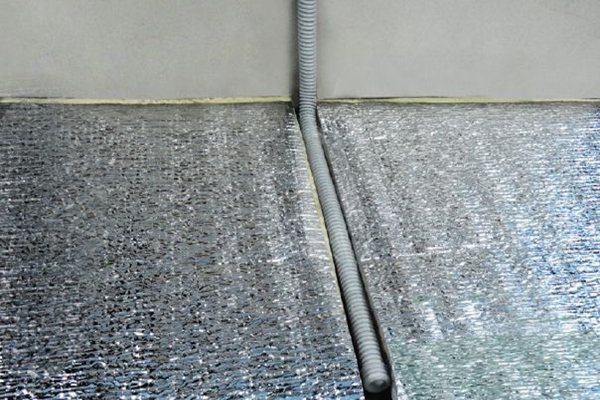
Reinforcement with reinforcement
Providing the necessary strength is achieved by reinforcement produced according to one of the following design solutions:
- single-layer mesh, woven structure;
- welded two-layer mesh frame.
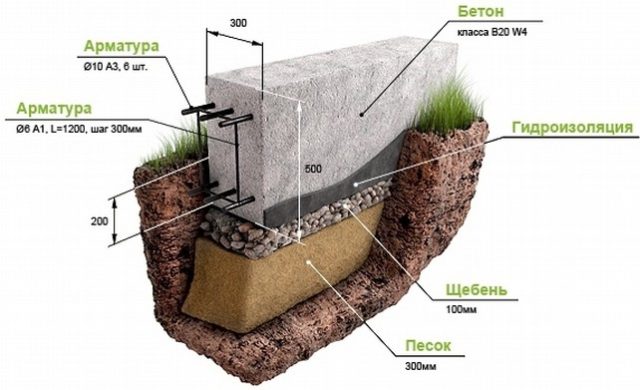
Foundation blocks mainly transfer the load to stable soil layers or to a prepared pad
The first option is used for narrow slabs up to 1.6 meters wide, and the second option is used for standard sizes of products increased to 3.2 meters.
The standard obliges, when installing a flat mesh or volumetric reinforcement frame, to maintain a distance from the reinforcement to the outer surface of at least 30 millimeters. A layer of concrete of the specified thickness will reliably protect steel reinforcement from the penetration of moisture, the destructive effects of corrosion.
To ensure the immobility of the reinforcement, non-metallic spacers must be used. The wire sizes differ depending on the design of the rigging devices and the number of attachment points. Its diameter ranges from 4 mm (for assortment BP-I) to 14 mm, corresponding to wire A-III.
Steel reinforcement, securely concreted in the cushion, comes out and forms a mounting loop. This element is necessary for movement during installation. The installation diagram for the rigging brackets is given in the appendix to this standard. The document regulates six options for fastening elements depending on the mass of the slab.
Features of a columnar strip foundation
Such a foundation is an attempt to combine the advantages of column and strip foundations in one design and eliminate their disadvantages as much as possible. I must say that this is a very successful experiment because it brings a number of advantages to this type of fund:
- Significant reduction in the volume of earthworks.
- Possibility of construction on medium and strongly curved soils, including peat soils.
- There is no need to make sandstone or sand cushions for the entire foundation.
- No drainage system required.
- Reduces consumption of concrete, reinforcement and working time.
- Heat losses are reduced and vibration insulation of the building is improved.
We also recommend reading the following article about polyurethane foam insulation: //6sotok-dom.com///.html.
Pillars
The main problem in our climate is the large difference between summer and winter temperatures, when the freezing of water in the ground in winter leads to high loads on the floor of the building.
One way to protect the foundation is to bury it deeper than the freezing level of the soil at the construction site. For example, for the Moscow region, depending on the type of soil, this value averages 1.4 meters.
It turns out that the depth of the foundation must exceed this value. The degree of excavation for a flat strip foundation can be assessed independently.
If piles are used, then only they are installed at this depth. Also evaluate the difference in the intensity of work and the number of cubic meters of land that you extracted yourself.
Strip foundation
The strip foundation (crane) in this design serves as a load-bearing element that absorbs and distributes the load from the walls.
As a rule, it does not come into contact with the ground, as it is located at a distance of 10-20 cm. If the belt is installed in the floor, for example if a flatter device has been chosen, it should be taken into account that it is also affected by the load from the floor due to temperature fluctuations .
To ensure that the belt does not pull away from the posts, it is necessary to provide such a design if it can also move during vertical movements, i.e. when working as a piston. Columns should be smooth and not have a flared base.
Find out how to properly strengthen a strip foundation: //612sotok-dom./fundament/123455321/armirovanie.html
Materials
The supports can be made from a variety of materials, from round wood to reinforced concrete. The shape is also round, square, hollow and polygonal.
If this is an independent building with minimal external attraction of forces and mechanisms, then a round concrete pillar is optimal.
How to make a sand pillow correctly
Knowing how to make a sand substrate yourself, you can significantly reduce the overall financial costs. The execution of the main set of work is preceded by special preparation.
Sequence of events:
- Plan out the construction site and mark out the outline using wooden pegs and string.
- Clear the surface of construction debris, remove large roots and existing vegetation.
- Extract fertile soil and form a pit at the depth specified by the project.
- Lay geotextile fabric on the soil surface to protect against waterlogging.
- Ensure delivery of coarse sand to the work site.
Having completed the preparatory activities, proceed to the next stage.
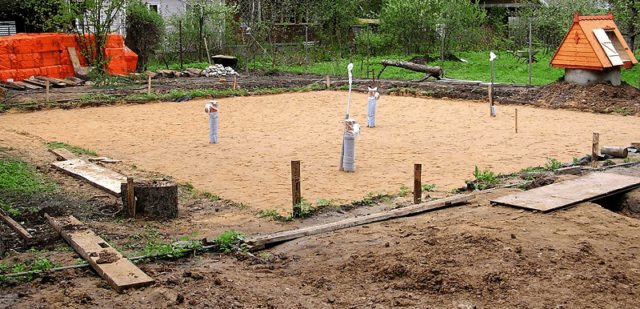
A sand cushion for the foundation is the simplest and cheapest type of bedding, so it is chosen by those who want to save money
Which sand is better
The type of sand you need depends on the area. Experts recommend using gravelly sand. It will provide compaction and the structure will not shrink after some time.
But some builders prefer a layer of sand and crushed stone, since this mixture prevents flooding and levels the surface.
Sand or crushed stone are popular materials, but sand and gravel cushions for foundations are no less often used.
What should be the thickness
Sand cushion is a base created artificially. It is made directly under the foundation. The shape and dimensions are calculated individually, taking into account the specific parameters of the supporting platform.

The calculation is made taking into account natural and climatic factors (type and depth of soil freezing, height of groundwater), the type of foundation being constructed, the type of structure being erected and its weight.
Under normal engineering and geological conditions, a 15 cm thick cushion is allowed to be formed under the strip foundation. According to Russian standards, the height of the compacted layer should be from 10 to 30 cm.
The construction of a slab foundation involves adding sand in a 10-15 cm layer.
The sand layer under the strip foundation of a one-story building is 15 cm, for a brick building with several floors - 25 cm.
In the construction of columnar and pile foundations, a sand and gravel layer up to 30 cm wide is used.
In some cases it reaches 60 cm.
Watch the video:
The thickness of the cushion constructed in areas with high groundwater levels (wetlands) is calculated by a specialist. Arranging a conventional layer in such cases is ineffective. Increased efficiency is facilitated by the adoption of additional measures: laying drainage systems, drainage.
Backfilling and compacting the sand cushion
The sand layer under the foundation is formed as follows:
- Build drainage for nearby groundwater.
- Pour coarse sand over the entire area.
- Form a layer of litter 20–25 cm thick.
- Ensure the surface is horizontal.
- Compact the layer of sand with a vibrating plate, moistening it generously with water.
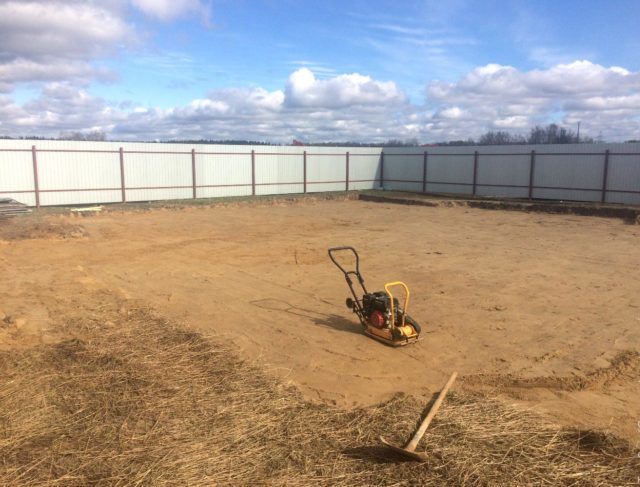
A sand cushion under a strip foundation saves the base from erosion and also ensures a permissible load on its lower part
Please note that the degree of compaction of the sand layer should be such as to eliminate shoe marks on the sandy surface. After filling the sand and completing its compaction, proceed with the construction of the foundation provided for by the requirements of the project.
Stages of work
Preparation of a foundation cushion can be divided into several stages:
- The thickness and width of the upholstery is calculated based on the properties of the soil, the climatic properties of the area and the weight of the building under construction;
- The territory is marked in accordance with the construction plan;
- digging a trench or digging a trench. Please note that its depth should correspond to the total height of the foundation and pillow;
- Geotextiles laid at the bottom of the trench are used to backfill and proportionally mix sand or grit (for dry cement weighing 330 kg, 1250 kg of gravel, 600 kg of sand and 180 liters of water must be added);
The last layer is compacted and leveled. A waterproofing layer is applied on top, which can be used as a roofing membrane or similar material.
At this point, the lining is finished and then the concrete foundation blocks are laid or poured, depending on the construction technology of the building's base.
The foundation is the foundation of any structure to ensure its safety, but it can successfully perform its functions if it has a cushion that protects it from unnecessary exposure to groundwater and temperature fluctuations.
Find out how to make the right foundation pad and why:
Page 2
There are many types of foundations, as well as stacks and belts in several variants, which differ both in the type of location of the wiper belt and in the type and technology of stacking.
If we look at the most common types, consider the advantages and disadvantages, we will determine how suitable they are for self-construction.
How to properly arrange a cushion of sand and crushed stone
Sand and crushed stone are currently considered a more accessible and cheaper option compared to precast/monolithic concrete. Provided the loads are not too heavy, sand and crushed stone are quite capable of providing excellent resistance to various loads, absorbing them and distributing them onto the ground. This choice will be ideal for a strip foundation:
The main advantages of a cushion made of sand and crushed stone:
- Simple and quick implementation of all activities, the ability to implement all stages with your own hands.
- Reduced thermal conductivity of materials, which allows you to retain heat inside the building.
- Reliability and density of the base, which has a positive effect on the entire building.
- Maximum uniform distribution of perceived loads of all types.
- Preventing the rise of moisture from the ground at the capillary level, protecting the entire structure from water.
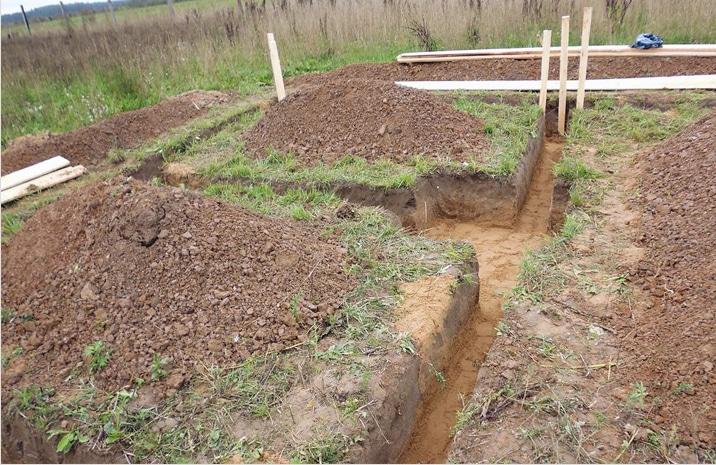
How to properly make a pillow from sand and crushed stone:
- Preparation of a trench or ditch according to pre-made markings at the site.
- Leveling the bottom of the trench, compacting.
- Laying a layer of geological textile with a margin around the edges (then the pillow will be covered with these parts on top).
- Filling with a layer of coarse river sand, carefully leveling, moistening, compacting with a special tool.
- Filling with medium-fraction crushed stone in a layer of up to 20 centimeters, uniform distribution of the layer, compaction with a vibrating plate.
- Laying a layer of sand 20 centimeters high, pouring it with water. In this way, it is possible to achieve the penetration of sand particles into the voids between the crushed stone, which will provide greater density.
- Cover the pillow with the free edges of geotextile. To avoid damaging the material when performing further work, you can pour a little more sand on top.
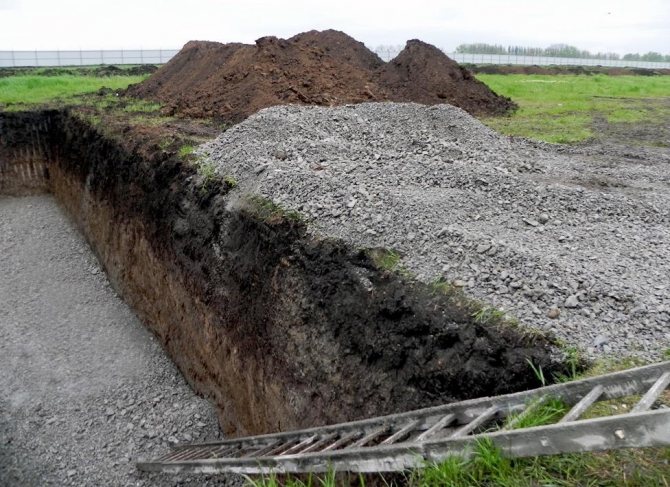
Calculation of the amount of material for arranging a crushed stone cushion
To determine the consumption of bulk material, it is necessary to know the volume of the substrate and the weight of the fraction involved. This indicator can be viewed either in the quality certificate, or you can use the general average value. The latter is 1450 kilograms per cubic meter. One ton of crushed stone fills a volume equal to 0.67 cubic meters. It is enough to divide the volume of the pillow by this parameter. The result is the required amount of crushed stone.
If it is possible to find out the exact weight of the fraction, the calculations will be more accurate. In addition, it is necessary to take into account the fact that the pillow is most often equipped with a combination pillow, which means that part of the volume will be taken up by river sand. Its consumption will increase when replacing the top layers of problematic soil. It is better to order bulk materials with a margin of 10-20 percent. Otherwise, you will have to make additional purchases later. We should not forget that crushed stone is also used for the foundation, so it will be needed more than just for a pillow.
Backfilling of crushed stone
The material is laid in layers, the minimum thickness of the backfill is 25 cm. When laying, the material is carefully leveled horizontally and compacted with moisture and the use of a construction vibrating plate.
The presence of sand in the crushed stone mass makes it possible to obtain a more dense layer that allows for high-quality compaction. The main task is to constantly control the horizontal surface of the backfill layer. If you do not check the condition and level, you can end up with a wavy layer with a noticeable slope, which is unacceptable.
PLEASE ATTENTION! The check is carried out with a construction or laser level with immediate correction of detected distortions or irregularities.



